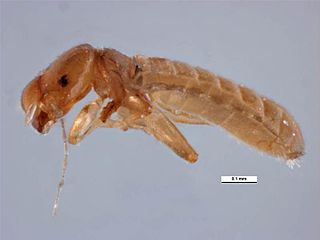
Psocoptera are a paraphyletic group of insects that are commonly known as booklice, barklice or barkflies. The name Psocoptera has been replaced with Psocodea in recent literature, with the inclusion of the former order Phthiraptera into Psocodea.

Psocomorpha is a suborder of barklice, booklice, and parasitic lice in the order Psocodea. There are more than 20 families and 5,300 described species in Psocomorpha.

Trogiomorpha is one of the three major suborders of barklice, booklice, and parasitic lice in the order Psocodea, alongside Troctomorpha and Psocomorpha. There are about 8 families and more than 430 described species in Trogiomorpha. Trogiomorpha is widely agreed to be the earliest diverging of the three suborders, and retains the most primitive characteristics.

Troctomorpha is one of the three major suborders of Psocodea (barklice, booklice, and parasitic lice), alongside Psocomorpha and Trogiomorpha. There are more than 30 families and 5,800 described species in Troctomorpha. The order includes parasitic lice, which are most closely related to the booklice family Liposcelididae.

Compsocidae is a family of Psocodea belonging to the suborder Troctomorpha. The family comprises two extant species in two genera, both found in Mesoamerica. Compsocus elegans is found in Mexico and Central America, while Electrentomopsis variegata is found in Mexico. The antennae of each species have 13 or 14 segments. Two extinct genera, Burmacompsocus and Paraelectrentomopsis are known from the Cenomanian aged Burmese amber of Myanmar.
Asiopsocidae is a family of Psocodea belonging to the infraorder Caeciliusetae. The family is composed of 14 known species of barklice in three genera: Asiopsocus, Notiopsocus, and Pronotiopsocus. One species from each genus has been found in the United States.

Ectopsocidae is a family of Psocodea belonging to the suborder Psocomorpha. The family includes fewer than 200 species, most of them in the genus Ectopsocus.

Trichopsocidae is a family of Psocodea belonging to the suborder Psocomorpha. The family includes 11 species in two genera.
Bryopsocidae a former family of Psocodea belonging to the suborder Psocomorpha. This family is now considered to be a junior synonym of the subfamily Zelandopsocinae within the family Pseudocaeciliidae.
Psilopsocidae is a family of Psocodea belonging to the infraorder Psocetae. Members of the family have a free areola postica and mottled wings. It is the only psocopteran family with records of wood-boring species. The family comprises one genus and seven species.

Caeciliusidae is a family of Psocodea belonging to the suborder Psocomorpha. The family was once named Caeciliidae, but the latter name was changed because of homonymy with the amphibian family Caeciliidae. The subfamily Paracaeciliinae was formerly in Caeciliusidae, but it has been elevated to family rank, Paracaeciliidae.

Homilopscocidea is an infraorder of Psocodea. It is probably a paraphyletic group, still in use for lack of a better solution. There are about 7 families and more than 1,200 described species in Homilopsocidea.

Psocodea is a taxonomic group of insects comprising the bark lice, book lice and parasitic lice. It was formerly considered a superorder, but is now generally considered by entomologists as an order. Despite the greatly differing appearance of parasitic lice (Phthiraptera), they are believed to have evolved from within the former order Psocoptera, which contained the bark lice and book lice, now found to be paraphyletic. They are often regarded as the most primitive of the hemipteroids. Psocodea contains around 11,000 species, divided among four suborders and more than 70 families. They range in size from 1–10 millimetres (0.04–0.4 in) in length.

Liposcelis bostrychophila is a species of booklouse in the family Liposcelididae. It is known nearly worldwide as a common pest of stored products. It is especially prevalent in cereals. In 2019 it was identified as a predator of mosquito eggs in a FAO/IAEA Insect Pest Control Laboratory which developed sterile males.

Liposcelis is a genus of insects in the order Psocoptera, the booklice and barklice. There are about 126 species. Many species are associated with human habitation and several are well known as pests of stored products. The genus is distributed nearly worldwide.
Liposcelis deltachi is a species of booklouse in the family Liposcelididae. It is found in Central America and North America.
Liposcelis hirsutoides is a species of booklouse in the family Liposcelididae. It is found in Central America, North America, and South America.
Liposcelis entomophila is a species of booklouse in the family Liposcelididae. It is found in Africa, Australia, the Caribbean Sea, Europe and Northern Asia, Central America, North America, South America, and Southern Asia.

Nanopsocetae is one of two major divisions of Troctomorpha in the order Psocodea, alongside Amphientometae. There are more than 20 families and 5,200 described species in Nanopsocetae.
Manicapsocidae is a family of Psocodea. It contains 8 extant species in 4 genera, with most of the species being found in the Neotropics, with one species in the Afrotropics. The extinct family Electrentomidae has been suggested to be a synonym of this family, though this has been considered premature by other scholars in the absence of cladistic analysis. Confirmed fossil species of the family are nearly as numerous as living ones, extending back to the Mid-Cretaceous.











